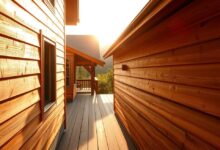Noise-Reducing Insulated Siding: Improve Your Home’s Comfort
Are you tired of the constant din of traffic or the chatter of neighbors disrupting your peaceful home life? Noise-reducing insulated siding can be a game-changer. This innovative solution not only helps in minimizing external noise but also enhances your home’s energy efficiency.
By installing insulated siding for noise reduction, homeowners can significantly improve their living experience. It creates a more serene indoor environment, making it easier to relax or focus.
Key Takeaways
- Reduces external noise pollution
- Enhances home energy efficiency
- Creates a more serene indoor environment
- Improves overall home comfort
- Increases property value with modern siding solutions
Understanding Noise Pollution and Its Impact on Home Comfort
Too much noise can really bother you. Knowing where it comes from and how it affects us is key to a quiet home. Noise pollution is a big problem that messes with our peace and health.
Common Sources of External Noise
Many things can make a lot of noise, like traffic, construction sites, and neighbors. These sounds can easily get into our homes and ruin our comfort.
How Noise Affects Health and Well-being
Being around too much noise can harm our health. It can make us stressed, keep us awake, and even hurt our hearts. We need to find ways to make our homes quieter to protect our health.
Traditional Siding’s Limitations in Sound Control
Old siding doesn’t do a great job of keeping out noise. It can’t block or soak up sounds well. This shows we need better options, like siding that helps reduce noise.
The Science Behind Insulated Siding for Noise Reduction
Insulated siding works well against noise thanks to science. It’s not just for protecting homes from weather. It also makes living spaces quieter by blocking outside sounds.
How Sound Travels Through Building Materials
Sound moves differently through various materials. Dense materials like brick or concrete pass sound better than lighter ones. Knowing how sound interacts with materials helps pick the best siding for quieting down.
Insulation Materials and Their Sound Absorption Properties
Insulation materials are key in reducing noise with insulated siding. Fiberglass, foam board, and mineral wool absorb sound well. They turn sound into heat, which is lost, making homes quieter.
Understanding STC Ratings for Siding Products
The Sound Transmission Class (STC) rating shows how well siding blocks sound. A higher STC means better soundproofing. Choosing siding with high STC ratings ensures it reduces noise effectively.
Knowing the science behind insulated siding helps homeowners choose wisely. They can pick siding that looks good and makes their home quieter and more comfortable.
Types of Noise-Reducing Insulated Siding Options
Homeowners looking to cut down on outside noise have many insulated siding choices. New building materials have led to several types of insulated siding. Each offers its own benefits in noise reduction.
Vinyl Insulated Siding Systems
Vinyl insulated siding is a favorite because it’s tough and easy to care for. It has foam backing that insulates and dampens sound. This makes it great for keeping noise out. Plus, it comes in many styles and colors, fitting any home.
Fiber Cement with Insulation Backing
Fiber cement siding with insulation backing is another good choice for quieting homes. It’s strong and stands up to weather. The insulation backing makes it even better at blocking sound, making it a solid pick.
Foam-Backed Siding Technologies
Foam-backed siding is known for its top-notch insulation against sound and heat. The foam helps keep noise out and saves energy. It’s built to last, too.
Comparing Cost vs. Performance
Choosing siding options means weighing cost against performance. Vinyl insulated siding might be cheaper at first, but fiber cement siding could be more valuable over time. Foam-backed siding might cost more, but it saves energy and reduces noise. It’s important to compare carefully.
A leading expert says, “The right siding can make a home more comfortable and energy-efficient.” By looking at the different insulated siding options, homeowners can find the best fit for their needs and budget.
“The right siding can significantly enhance a home’s comfort and energy efficiency.”
– Expert in Building Materials
Benefits Beyond Noise Reduction
Insulated siding does more than just block out noise. It also makes your home more comfortable and energy-efficient. This siding brings many benefits that can really improve your life.
Energy Efficiency and Utility Cost Savings
One big plus of insulated siding is its energy efficiency. It adds an extra layer of insulation. This means less heat loss in winter and less heat gain in summer. You can save a lot on your utility bills over time.

Improved Temperature Regulation Year-Round
Insulated siding helps keep your home at a steady temperature all year. It stops heat from escaping or entering too much. This makes your home warmer in winter and cooler in summer. It also makes your heating and cooling systems work less hard.
Enhanced Exterior Durability and Home Value
Insulated siding is also very durable. It can last for decades with just a little care. This can make your home more valuable. It also stands up to weather, saving you from expensive repairs.
Installation and Maintenance for Maximum Noise Control
The success of insulated siding in cutting down noise depends on how it’s set up and cared for. Getting it installed right ensures it works best. Keeping it up also helps it last longer and keep noise out.
Professional vs. DIY Installation Considerations
Homeowners face a choice between a pro or DIY for insulated siding. Professional installation brings the benefit of skill and knowledge, making sure the siding works well. DIY, while cheaper, needs careful work and following the maker’s rules.
Here’s a look at the pros and cons of each:
| Installation Method | Cost | Expertise Required | Potential for Errors |
|---|---|---|---|
| Professional Installation | Higher | High | Lower |
| DIY Installation | Lower | Moderate to High | Higher |
Critical Installation Techniques for Optimal Sound Dampening
To dampen sound best, some key steps are needed. These include a tight seal around edges and holes, the right fasteners, and siding that’s straight. Proper sealing is key because gaps can ruin the siding’s sound-blocking power.
Also, the insulation’s quality and how it’s put in matters a lot. It must be installed without damage or squish.
Long-Term Maintenance Requirements
Keeping insulated siding in good shape is key for long-term use. This means regular cleaning, checking for damage, and fixing problems fast. Regular checks help spot issues early, keeping the siding effective.
By focusing on right installation and upkeep, homeowners can enjoy quieter homes. This makes living spaces more comfortable and peaceful.
Conclusion
Noise-reducing insulated siding is a great choice for homeowners. It cuts down on outside noise and boosts energy efficiency. Plus, it makes your home last longer.
There are many types of insulated siding out there. You can choose from vinyl, fiber cement, or foam-backed siding. Knowing how sound works and what STC ratings mean can help you pick the best one.
Insulated siding makes your home quieter and more comfortable. It also saves you money on bills and increases your home’s value. It’s a smart choice for anyone wanting a better living space.









